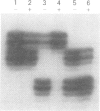Abstract
Dyskeratosis congenita (DC) is a rare inherited disorder characterised by the early onset of reticulate skin pigmentation, nail dystrophy, and mucosal leucoplakia. In over 80% of cases bone marrow failure develops and this is the main cause of early mortality. The DC1 gene responsible for the X linked form (MIM 305000) of dyskeratosis congenita has been mapped to Xq28. In order to narrow the candidate gene region, genetic linkage analysis was performed in eight X linked pedigrees using a set of markers spanning Xq28. A maximum lod score of 5.31 with no recombinations was achieved with marker DXS1073. Two recombination events were identified; one of these uses X chromosome inactivation pattern analysis to determine carrier status and haplotype analysis to fine map the recombination breakpoint. The fine mapping of these recombination events has enabled the candidate gene region for X linked dyskeratosis congenita to be defined as the 1.4 Mb interval between Xq3274 and DXS1108.
Full text
PDF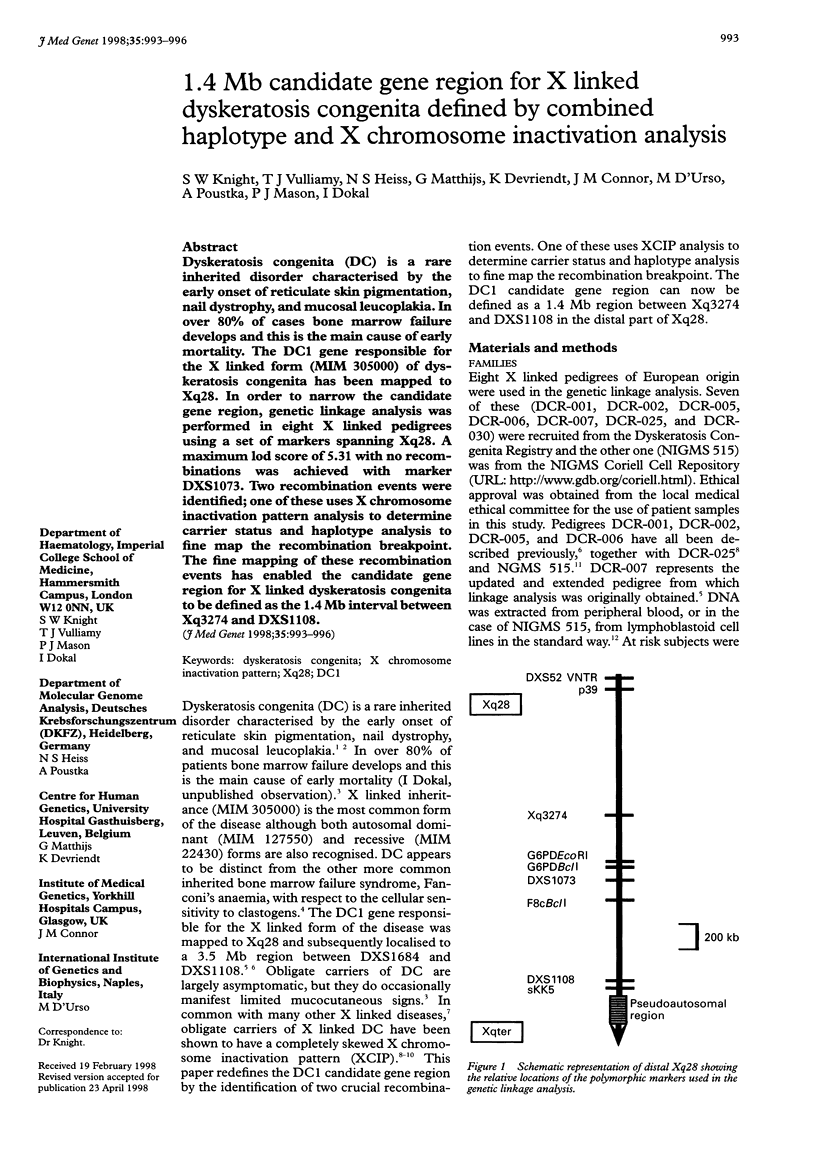
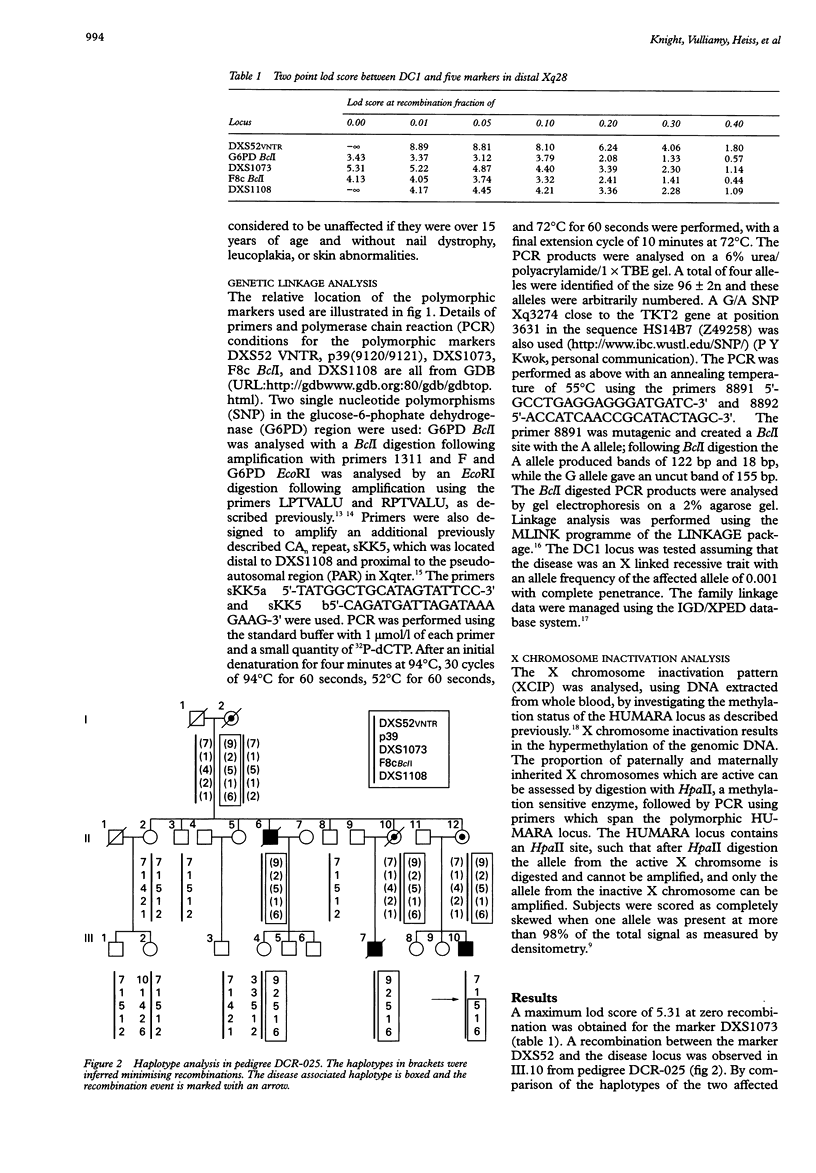
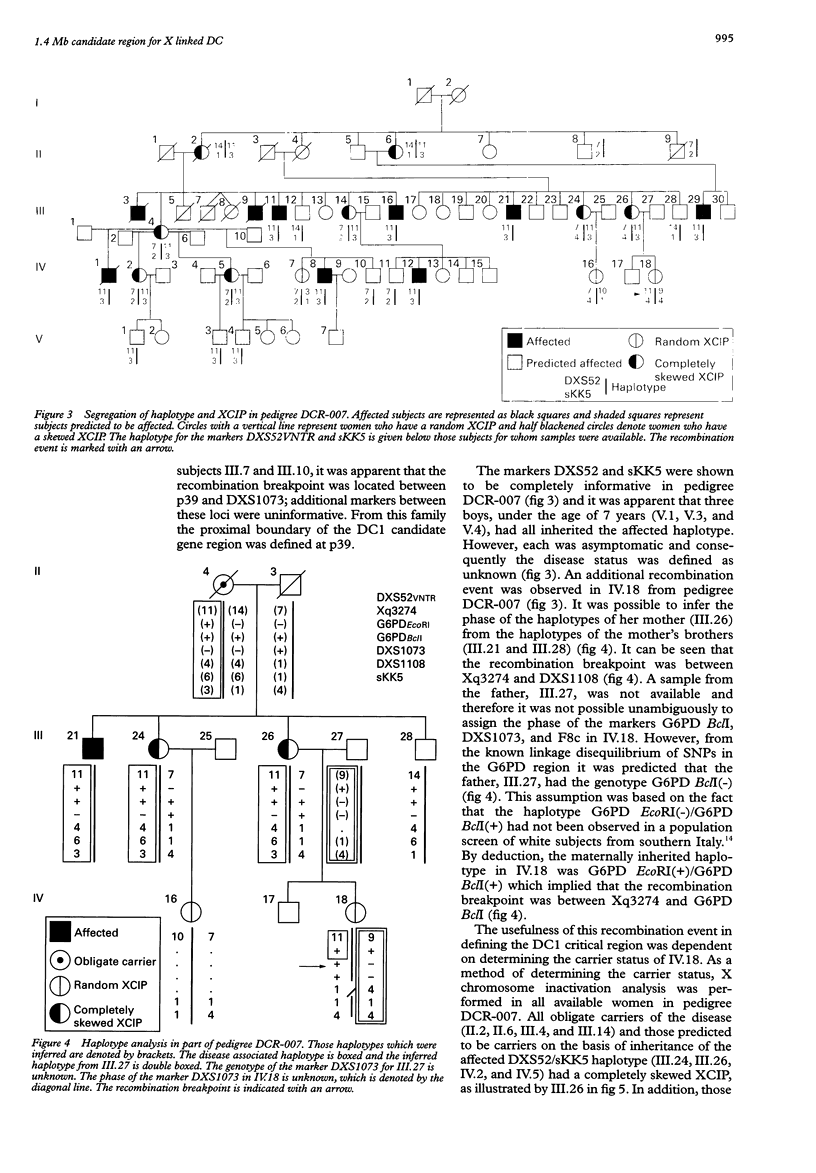
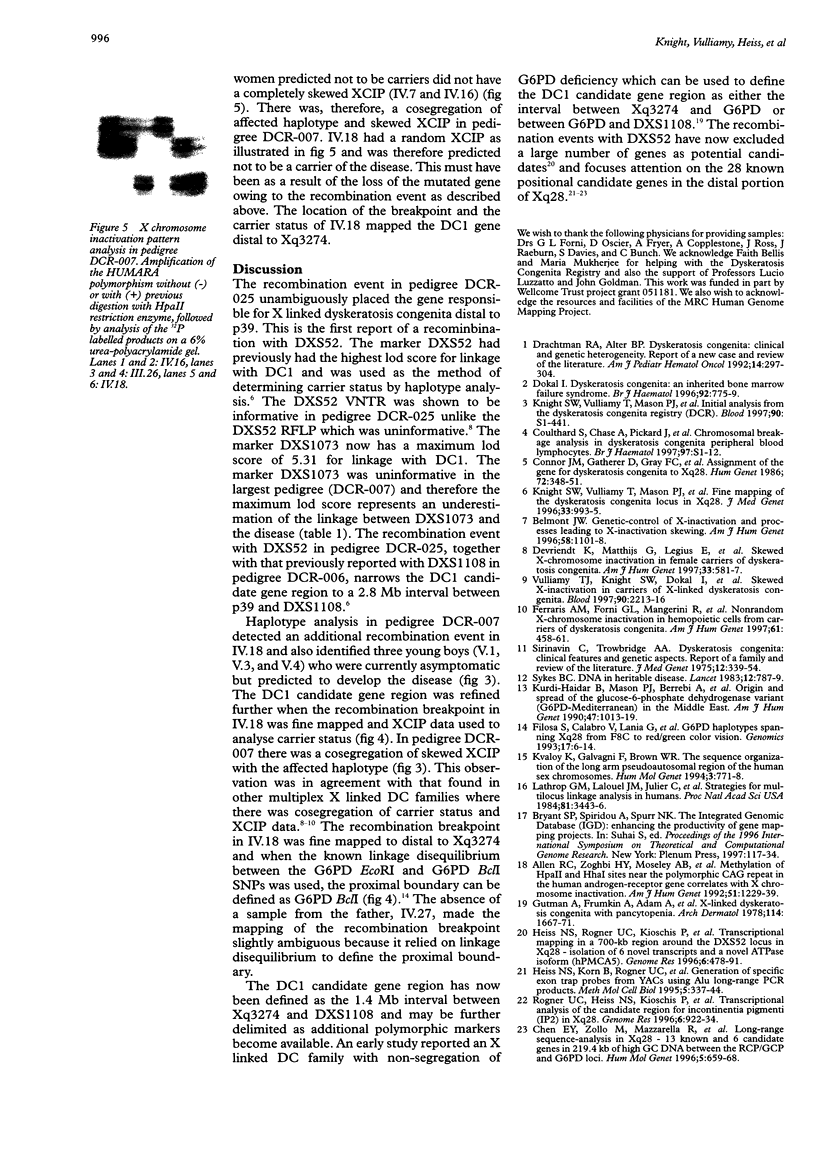
Images in this article
Selected References
These references are in PubMed. This may not be the complete list of references from this article.
- Allen R. C., Zoghbi H. Y., Moseley A. B., Rosenblatt H. M., Belmont J. W. Methylation of HpaII and HhaI sites near the polymorphic CAG repeat in the human androgen-receptor gene correlates with X chromosome inactivation. Am J Hum Genet. 1992 Dec;51(6):1229–1239. [PMC free article] [PubMed] [Google Scholar]
- Belmont J. W. Genetic control of X inactivation and processes leading to X-inactivation skewing. Am J Hum Genet. 1996 Jun;58(6):1101–1108. [PMC free article] [PubMed] [Google Scholar]
- Chen E. Y., Zollo M., Mazzarella R., Ciccodicola A., Chen C. N., Zuo L., Heiner C., Burough F., Repetto M., Schlessinger D. Long-range sequence analysis in Xq28: thirteen known and six candidate genes in 219.4 kb of high GC DNA between the RCP/GCP and G6PD loci. Hum Mol Genet. 1996 May;5(5):659–668. doi: 10.1093/hmg/5.5.659. [DOI] [PubMed] [Google Scholar]
- Connor J. M., Gatherer D., Gray F. C., Pirrit L. A., Affara N. A. Assignment of the gene for dyskeratosis congenita to Xq28. Hum Genet. 1986 Apr;72(4):348–351. doi: 10.1007/BF00290963. [DOI] [PubMed] [Google Scholar]
- Devriendt K., Matthijs G., Legius E., Schollen E., Blockmans D., van Geet C., Degreef H., Cassiman J. J., Fryns J. P. Skewed X-chromosome inactivation in female carriers of dyskeratosis congenita. Am J Hum Genet. 1997 Mar;60(3):581–587. [PMC free article] [PubMed] [Google Scholar]
- Dokal I. Dyskeratosis congenita: an inherited bone marrow failure syndrome. Br J Haematol. 1996 Mar;92(4):775–779. doi: 10.1046/j.1365-2141.1996.355881.x. [DOI] [PubMed] [Google Scholar]
- Drachtman R. A., Alter B. P. Dyskeratosis congenita: clinical and genetic heterogeneity. Report of a new case and review of the literature. Am J Pediatr Hematol Oncol. 1992 Nov;14(4):297–304. [PubMed] [Google Scholar]
- Ferraris A. M., Forni G. L., Mangerini R., Gaetani G. F. Nonrandom X-chromosome inactivation in hemopoietic cells from carriers of dyskeratosis congenita. Am J Hum Genet. 1997 Aug;61(2):458–461. doi: 10.1016/S0002-9297(07)64075-0. [DOI] [PMC free article] [PubMed] [Google Scholar]
- Filosa S., Calabrò V., Lania G., Vulliamy T. J., Brancati C., Tagarelli A., Luzzatto L., Martini G. G6PD haplotypes spanning Xq28 from F8C to red/green color vision. Genomics. 1993 Jul;17(1):6–14. doi: 10.1006/geno.1993.1276. [DOI] [PubMed] [Google Scholar]
- Gutman A., Frumkin A., Adam A., Bloch-Shtacher N., Rozenszajn L. A. X-linked dyskeratosis congenita with pancytopenia. Arch Dermatol. 1978 Nov;114(11):1667–1671. [PubMed] [Google Scholar]
- Heiss N. S., Rogner U. C., Kioschis P., Korn B., Poustka A. Transcription mapping in a 700-kb region around the DXS52 locus in Xq28: isolation of six novel transcripts and a novel ATPase isoform (hPMCA5). Genome Res. 1996 Jun;6(6):478–491. doi: 10.1101/gr.6.6.478. [DOI] [PubMed] [Google Scholar]
- Knight S. W., Vulliamy T., Forni G. L., Oscier D., Mason P. J., Dokal I. Fine mapping of the dyskeratosis congenita locus in Xq28. J Med Genet. 1996 Dec;33(12):993–995. doi: 10.1136/jmg.33.12.993. [DOI] [PMC free article] [PubMed] [Google Scholar]
- Kurdi-Haidar B., Mason P. J., Berrebi A., Ankra-Badu G., al-Ali A., Oppenheim A., Luzzatto L. Origin and spread of the glucose-6-phosphate dehydrogenase variant (G6PD-Mediterranean) in the Middle East. Am J Hum Genet. 1990 Dec;47(6):1013–1019. [PMC free article] [PubMed] [Google Scholar]
- Kvaløy K., Galvagni F., Brown W. R. The sequence organization of the long arm pseudoautosomal region of the human sex chromosomes. Hum Mol Genet. 1994 May;3(5):771–778. doi: 10.1093/hmg/3.5.771. [DOI] [PubMed] [Google Scholar]
- Lathrop G. M., Lalouel J. M., Julier C., Ott J. Strategies for multilocus linkage analysis in humans. Proc Natl Acad Sci U S A. 1984 Jun;81(11):3443–3446. doi: 10.1073/pnas.81.11.3443. [DOI] [PMC free article] [PubMed] [Google Scholar]
- Rogner U. C., Heiss N. S., Kioschis P., Wiemann S., Korn B., Poustka A. Transcriptional analysis of the candidate region for incontinentia pigmenti (IP2) in Xq28. Genome Res. 1996 Oct;6(10):922–934. doi: 10.1101/gr.6.10.922. [DOI] [PubMed] [Google Scholar]
- Sirinavin C., Trowbridge A. A. Dyskeratosis congenita: clinical features and genetic aspects. Report of a family and review of the literature. J Med Genet. 1975 Dec;12(4):339–354. doi: 10.1136/jmg.12.4.339. [DOI] [PMC free article] [PubMed] [Google Scholar]
- Sykes B. C. DNA in heritable disease. Lancet. 1983 Oct 1;2(8353):787–788. doi: 10.1016/s0140-6736(83)92314-0. [DOI] [PubMed] [Google Scholar]
- Vulliamy T. J., Knight S. W., Dokal I., Mason P. J. Skewed X-inactivation in carriers of X-linked dyskeratosis congenita. Blood. 1997 Sep 15;90(6):2213–2216. [PubMed] [Google Scholar]




